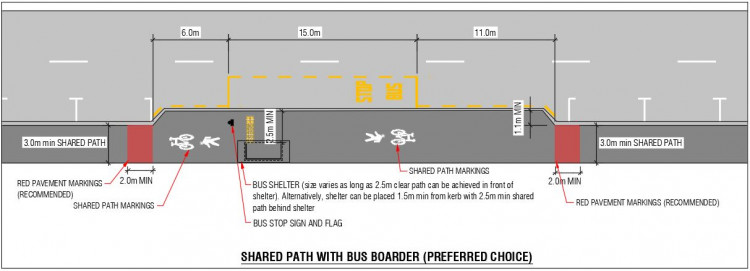Where a bus stop is next to a shared path, the design considerations are similar to those for bus stops next to cycleways. Passengers need to be warned that they are stepping into a path where cyclists may be present, and oncoming cyclists need to be warned of passengers crossing their path.
The design elements are similar to those for a standard bus stop, but on a wider path.
Key considerations and differences are as follows.
For more information, see:
PTDG: General clearance requirements
The figure below shows the design elements of a bus stop with a bus boarder – the preferred design on a shared path. This preferred design requires a minimum 1.1m bus boarder kerb build out. To achieve the desired 2.5m clear width in front of the bus shelter build out a wider boarder or have a narrower shelter (for example, cantilever).
The preferred design places the bus shelter at the back of the shared path. The shelter may be toward the front of the shared path only if a clear path exists of at least 1.5m (1.2m absolute minimum) in front of the shelter and 2.5m behind the shelter. This separates bus passengers and shared path users. Note the shelter sides need to be clear or transparent to allow visibility between path users coming from either direction.

Bus stop with bus boarder to support shared path. View larger image [JPG, 74 KB]
Where the preferred design of a shared path with bus boarder (figure above) cannot be achieved, consider a shared boarding zone design (see figure below).

Shared path with shared zone boarding design. View larger image [JPG, 73 KB]
With the shared boarding zone design: